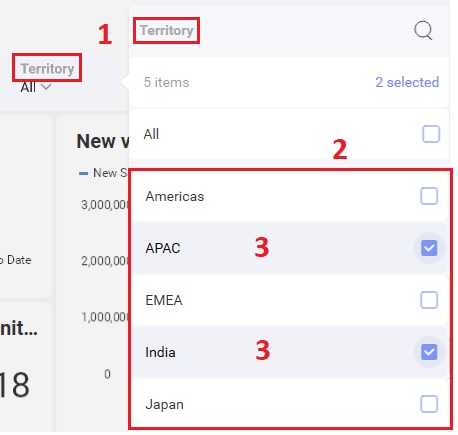Filtering Dashboards
Filters are located along the top of a Dashboard and can be modified using the Reveal SDK.

There are two kinds of filters:
- The Date Filter
- Dashboard Filters
Date Filter
The Date Filter is a special kind of filter as it does not have any data associated with it. There’s not a list of values to select from, instead you select a date interval or range. You can choose from a list of predefined date intervals such as "Today", “All Time”, “Previous Month”, or specify your own custom range (from Jan 12, 2019 to Jan 12, 2021).
The Date Filter is always the first filter and there can be only one Date Filter.

Using a Date Interval
To set the dashboard's Date Filter using a predefined set of date intervals, you must set the Dashboard.dateFilter property to a new instance of a RVDateDashboardFilter object and use the appropriate RVDateFilterType value as a parameter.
For example; this code snippet will set the dashboard's date filter to YearToDate:
revealView.dashboard.dateFilter = new $.ig.RVDateDashboardFilter($.ig.RVDateFilterType.YearToDate);
Here you can see the dashboard UI updated it's Date Filter to Year To Date
The RVDateFilterType has the following values:
- AllTime
- CustomRange
- LastMonth
- LastWeek
- LastYear
- MonthToDate
- NextMonth
- NextQuarter
- NextYear
- PreviousMonth
- PreviousQuarter
- PreviousYear
- QuarterToDate
- ThisMonth
- ThisQuarter
- ThisYear
- Today
- TrailingTwelveMonths
- YearToDate
- Yesterday
Using a Custom Date Range
To set a custom date range, you must set the Dashboard.dateFilter property to a new instance of a RVDateDashboardFilter object, and use the RVDateFilterType.CustomRange value as a parameter and provide a RVDateRange (which provides the fromDate and toDate arguments) as the second parameter.
In this example, we set the DateFilter to a custom date range spanning the last 75 days:
var fromDate = new Date();
fromDate.setDate(fromDate.getDate() - 75);
var toDate = new Date();
var dateRange = new $.ig.RVDateRange(fromDate, toDate);
revealView.dashboard.dateFilter = new $.ig.RVDateDashboardFilter($.ig.RVDateFilterType.CustomRange, dateRange);
Here you can see the dashboard UI updated it's Date Filter to display the date range
You can find a sample demonstrating Date Filters on GitHub.
Dashboard Filters
Dashboard Filters are displayed after the Date Filter, if a Date Filter is defined, and you can have multiple dashboard filters defined for a single dashboard. In this image, there are three dashboard filters defined (Territory, Employee, Product).

When working with dashboard filters, the main object you need to be aware of is the RVDashboardFilter object. The RVDashboardFilter object represents an individual filter that has been defined for a dashboard. It contains information about the filter such as the filter's title, available values to choose from, as well as what values are currently selected.
The RVDashboardFilter object has the following properties and methods:
- id - a unique ID of the filter, usually a GUID
- title (1) - the name of the filter. It is also used as the header of the filter in the dashboard filters UI
- selectedValues (3) - a collection of values that have been selected for the filter. They are represented in the UI by checkboxes within the filter dropdown
- getFilterValues() (2) - returns a collection of all filter values that are available for the filter. These act as options in a drop down list to choose which filter values to apply/select

Get All Filters
Dashboard filters can be accessed by using the RVDashboard.filters property. The RVDashboard.filters property will return all filters that have been defined for the dashboard.
var allDashboardFilters = revealView.dashboard.filters;
The RVDashboard.filters property returns a read-only collection of RVDashboardFilter objects.
Get a Specific Filter
The Reveal SDK provides an API to get a specific dashboard filter without having to loop through the RVDashboard.filters property. Instead, you can use either the RVDashboard.filters.getById or the RVDashboard.filters.getByTitle method.
Get by Id
var territoryFilter = revealView.dashboard.filters.getById("ddf3fa65-6893-4d8b-73ad-0b28fc1af330");
Get by Title
var territoryFilter = revealView.dashboard.filters.getByTitle("Territory");
These methods will return a RVDashboardFilter object which represents a specific dashboard filter.
Get Available Filter Values
To get a collection of all available filter values for a dashboard filter, use the RVDashboardFilter.getFilterValues() method.
var territoryFilter = revealView.dashboard.filters.getByTitle("Territory");
territoryFilter.GetFilterValues( filterValues => {
//handle filterValues
});
The RVDashboardFilter.getFilterValues() method will return a collection of RVFilter objects.
The RVFilter object has the following properties:
- label - the text that is displayed in the filter dropdown UI.
- value - the underlying value of the
RVFilterobject.
Get Selected Filter Values
To get a collection of the currently selected filter values for a dashboard filter, you can use the RVDashboardFilter.selectedValues property.
var territoryFilter = revealView.dashboard.filters.getByTitle("Territory");
var selectedFilterValues = territoryFilter.selectedValues;
Set Selected Filter Values
You can programmatically set the selected value(s) for a dashboard filter by using the RVDashboardFilter.selectedValues property. Simply set the RVDashboardFilter.selectedValues property to a new instance of an array. The array must contain all the filter values you want to have selected within the dashboard filter.
Set a Single Selected Filter Value
var territoryFilter = revealView.dashboard.filters.getByTitle("Territory");
territoryFilter.selectedValues = [ "Japan" ];
Set Multiple Selected Filters
var territoryFilter = revealView.dashboard.filters.getByTitle("Territory");
territoryFilter.selectedValues = [ "Japan", "India" ];
Clear Selected Filters
In order to clear any filter values that have been selected for a specific dashboard filter, simply set the RVDashboardFilter.selectedValues property to a new empty array.
var territoryFilter = revealView.dashboard.filters.getByTitle("Territory");
territoryFilter.selectedValues = [];
You can find a sample demonstrating Dashboard Filters on GitHub.
Hiding Filters
When using custom filter UI's or other custom filtering interactions, you may want to hide the panel containing the filters in the RevealView so the end-user won't get confused filtering the dashboard. You can hide the date and dashboard filters by setting the RevealView.showFilters property to false.
revealView.showFilters = false;